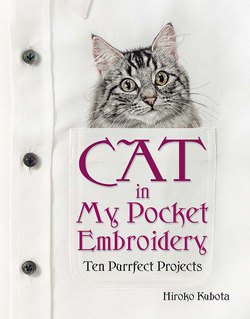Читать книгу Cat in My Pocket Embroidery - Hiroko Kubota - Страница 13
На сайте Литреса книга снята с продажи.
ОглавлениеSTITCHING TECHNIQUE
Using just a needle and single strands of embroidery floss, you can achieve soft color-shading effects and replicate the patterns and textures of a cat’s fur.
LONG AND SHORT STITCH
Painting with thread uses a stitching technique called long and short stitch, although the name is slightly misleading, since long and short stitches are used to start an area of embroidery, but the shading is actually completed using irregular satin stitches. The first row of stitches will feature alternate long and short stitches, but subsequent rows use stitches of roughly equal length, staggered to fill in the gaps of the previous row. You use your needles like a paintbrush, filling in color changes and light and shade. You may bring your needle up next to preceding stitches or through them, and may even pierce the thread of existing stitches.
To work the first row, alternate long and short stitches.
Fill in the gaps with a row of satin stitches.
Now fill in the next gaps with more satin stitches.
The stitches at the edges are long and short again.
You can keep the overlap between stitches short. . .
. . .or long.
NATURAL COLOR GRADATION
To create natural-looking cats you will use lots of threads, often in very similar shades. By using multiple colors you can create smooth and subtle gradations. For example, while moving in color between black and white, you might expect to need to use a gray. In fact, look closely at a photograph of a cat and you will see that various shades of gray, and perhaps browns too, are apparent between the extremes of white and black. Don’t be afraid to use lots of threads: we are lucky to have so many shades available.
To understand what I mean, start with two distinct colors.
Work between those colors with similar shades to begin to soften the transition.
Keep building a natural gradation using slightly differing shades of thread color.
TEXTURE
The long and short stitch technique is perfect for replicating the direction of a cat’s fur. Every cat is unique, so study the furry details and use your stitches like brushstrokes, changing their size and direction to emulate the nap or texture of the fur. That said, the changes in direction, like the changes in color, need to be subtle, so keep your stitches roughly parallel with only small changes each time as you round a corner or make a change in direction.
Embossed stitches make the paw stand out.
THREE DIMENSIONS
As you continue to layer your stitching to build color gradations and realistic textures, the embroidery will get thicker. This thread overlap naturally creates a 3-D effect, which is something you can use to your advantage. If you want some areas to stand out, use stitch layering to create that effect, working over some areas by embossing stitches on top of other stitches.
If your cat has smooth, even fur, then you need to be careful not to create an unwanted 3-D effect by overembossing any areas.
